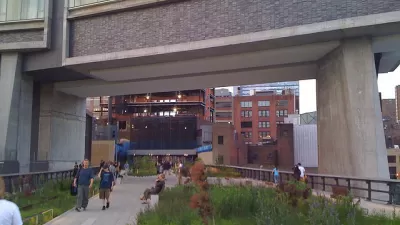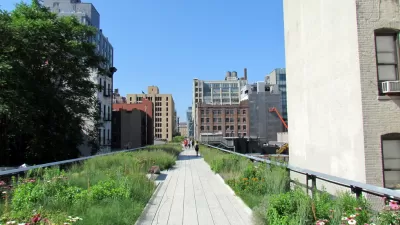An elevated walkway along Chicago’s LaSalle Street would not foster the vibrant street life that proponents envision.

Blair Kamin argues that Chicago should not jump on the High Line bandwagon in considering the future of the LaSalle Street corridor downtown. With vacancies on the rise in the area, one proposal considers an elevated walkway stretching over LaSalle to draw pedestrians and energize the area.
But Kamin says this is the wrong way to go for a street with an impressive collection of architectural treasures. "Plop an elevated walkway in this sublime canyon and you would mar the beautifully detailed ground-level facades of LaSalle’s buildings, throwing them into perpetual, Lower Wacker gloom. The street would be rendered virtually unrecognizable."
Instead of what would be a feeble attempt at duplicating other projects, Kamin suggests looking to a longer-term plan for the area, including turning office space into apartments and revitalizing existing public spaces.
"In short, the way to confront the central Loop’s looming vacancies is to build carefully on existing strengths, rather than reach desperately for a hideous quick fix that would destroy one of the city’s great urban spaces," adds Kamin.
FULL STORY: Column: Want to stop the central Loop exodus? A LaSalle Street ‘High Line’ is not the answer.

Trump Administration Could Effectively End Housing Voucher Program
Federal officials are eyeing major cuts to the Section 8 program that helps millions of low-income households pay rent.

Planetizen Federal Action Tracker
A weekly monitor of how Trump’s orders and actions are impacting planners and planning in America.

Ken Jennings Launches Transit Web Series
The Jeopardy champ wants you to ride public transit.

Rebuilding Smarter: How LA County Is Guiding Fire-Ravaged Communities Toward Resilience
Los Angeles County is leading a coordinated effort to help fire-impacted communities rebuild with resilience by providing recovery resources, promoting fire-wise design, and aligning reconstruction with broader sustainability and climate goals.

When Borders Blur: Regional Collaboration in Action
As regional challenges outgrow city boundaries, “When Borders Blur” explores how cross-jurisdictional collaboration can drive smarter, more resilient urban planning, sharing real-world lessons from thriving partnerships across North America.

Philadelphia Is Expanding its Network of Roundabouts
Roundabouts are widely shown to decrease traffic speed, reduce congestion, and improve efficiency.
Urban Design for Planners 1: Software Tools
This six-course series explores essential urban design concepts using open source software and equips planners with the tools they need to participate fully in the urban design process.
Planning for Universal Design
Learn the tools for implementing Universal Design in planning regulations.
Ada County Highway District
Clanton & Associates, Inc.
Jessamine County Fiscal Court
Institute for Housing and Urban Development Studies (IHS)
City of Grandview
Harvard GSD Executive Education
Toledo-Lucas County Plan Commissions
Salt Lake City
NYU Wagner Graduate School of Public Service





























